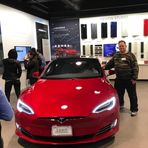The Rise of Robotaxis: Waymo's Bold Expansion in the U.S.
June 19, 2025, 4:40 pm

Location: United States, California, Mountain View
Employees: 1001-5000
Founded date: 2009
Total raised: $19.17B

Location: United States, Texas, Austin
Employees: 10001+
Founded date: 2003
Total raised: $3.86B
Waymo is on the move. The self-driving technology company, a subsidiary of Alphabet, is expanding its robotaxi services across the San Francisco Bay Area and beyond. This is not just a local story; it’s a glimpse into the future of transportation. As Waymo gears up to broaden its reach, the competition is heating up. Tesla is preparing to launch its own robotaxi service in Austin, Texas. The race is on, and the stakes are high.
Waymo’s recent expansion into more areas of the San Francisco peninsula and parts of Silicon Valley marks a significant milestone. The company is now the sole commercial robotaxi operator in the U.S. This is no small feat. With over 1,500 vehicles in its fleet, Waymo is already running more than 250,000 rides each week across major cities like San Francisco, Los Angeles, Phoenix, and Austin. The numbers tell a story of ambition and innovation.
California has given Waymo the green light to expand operations. This approval is a crucial step. It allows Waymo to test the waters in new neighborhoods, bringing its autonomous vehicles closer to everyday users. The streets of San Francisco will soon see more of these self-driving cars, weaving through traffic like a school of fish. The company’s strategy is clear: scale up and dominate the market.
But Waymo is not stopping at California. The company is also returning to New York City for testing. This is a bold move. New York is a bustling metropolis, a concrete jungle where the challenges of autonomous driving multiply. Waymo's vehicles will hit the streets next month, aiming to gather data and refine their technology. The company had previously tested its cars in Manhattan back in 2021, but this time, the stakes are higher. The goal is to secure an autonomous driving permit, a key to unlocking the city’s vast potential.
The race to deploy robotaxis is accelerating. Tesla is not sitting idle. The electric vehicle giant is set to begin limited trials of its own autonomous taxi service. With just ten cars on the road initially, Tesla is testing the waters in Austin. This competition is a double-edged sword. It pushes innovation but also raises questions about safety and regulation.
Waymo’s expansion is not just about numbers. It’s about changing the way we think about transportation. Imagine a world where cars drive themselves, freeing up time for passengers. No more traffic jams or parking woes. Just hop in, and let the car take you where you need to go. This vision is becoming a reality, but it comes with challenges.
Safety is paramount. Autonomous vehicles must navigate complex urban environments. They need to respond to unpredictable human behavior. Waymo has invested heavily in technology to ensure its cars can handle these challenges. The company’s vehicles are equipped with advanced sensors and artificial intelligence. They learn from every ride, becoming smarter with each mile.
Public perception is another hurdle. Many people are still skeptical about self-driving cars. Trust must be earned. Waymo is working to build that trust through transparency and safety records. The more people see these vehicles operating smoothly, the more confidence they will have in the technology.
Regulatory hurdles also loom large. Each state has its own rules governing autonomous vehicles. Waymo’s expansion into new areas requires navigating these regulations carefully. The company must work closely with local governments to ensure compliance. This is a delicate dance, balancing innovation with the need for oversight.
As Waymo pushes forward, the implications are profound. The rise of robotaxis could reshape urban landscapes. Fewer cars on the road could lead to reduced congestion and lower emissions. Public transportation systems might evolve to integrate with autonomous services, creating a seamless travel experience.
However, the transition will not be without its challenges. Job displacement is a concern. As self-driving technology becomes mainstream, traditional driving jobs may dwindle. Society must find ways to adapt, retraining workers for new roles in a changing economy.
The future of transportation is unfolding before our eyes. Waymo’s expansion is a significant chapter in this story. The company is not just a player in the game; it’s a leader. As it ventures into new territories, it sets the stage for others to follow. The road ahead is filled with possibilities.
In conclusion, Waymo’s bold moves in the robotaxi space are a testament to the rapid evolution of technology. The expansion into the San Francisco Bay Area and the return to New York City signal a new era in transportation. As competition heats up, the race for autonomous vehicles will only intensify. The journey has just begun, and the destination is a future where self-driving cars are as common as the yellow cabs of New York. Buckle up; it’s going to be an exciting ride.
Waymo’s recent expansion into more areas of the San Francisco peninsula and parts of Silicon Valley marks a significant milestone. The company is now the sole commercial robotaxi operator in the U.S. This is no small feat. With over 1,500 vehicles in its fleet, Waymo is already running more than 250,000 rides each week across major cities like San Francisco, Los Angeles, Phoenix, and Austin. The numbers tell a story of ambition and innovation.
California has given Waymo the green light to expand operations. This approval is a crucial step. It allows Waymo to test the waters in new neighborhoods, bringing its autonomous vehicles closer to everyday users. The streets of San Francisco will soon see more of these self-driving cars, weaving through traffic like a school of fish. The company’s strategy is clear: scale up and dominate the market.
But Waymo is not stopping at California. The company is also returning to New York City for testing. This is a bold move. New York is a bustling metropolis, a concrete jungle where the challenges of autonomous driving multiply. Waymo's vehicles will hit the streets next month, aiming to gather data and refine their technology. The company had previously tested its cars in Manhattan back in 2021, but this time, the stakes are higher. The goal is to secure an autonomous driving permit, a key to unlocking the city’s vast potential.
The race to deploy robotaxis is accelerating. Tesla is not sitting idle. The electric vehicle giant is set to begin limited trials of its own autonomous taxi service. With just ten cars on the road initially, Tesla is testing the waters in Austin. This competition is a double-edged sword. It pushes innovation but also raises questions about safety and regulation.
Waymo’s expansion is not just about numbers. It’s about changing the way we think about transportation. Imagine a world where cars drive themselves, freeing up time for passengers. No more traffic jams or parking woes. Just hop in, and let the car take you where you need to go. This vision is becoming a reality, but it comes with challenges.
Safety is paramount. Autonomous vehicles must navigate complex urban environments. They need to respond to unpredictable human behavior. Waymo has invested heavily in technology to ensure its cars can handle these challenges. The company’s vehicles are equipped with advanced sensors and artificial intelligence. They learn from every ride, becoming smarter with each mile.
Public perception is another hurdle. Many people are still skeptical about self-driving cars. Trust must be earned. Waymo is working to build that trust through transparency and safety records. The more people see these vehicles operating smoothly, the more confidence they will have in the technology.
Regulatory hurdles also loom large. Each state has its own rules governing autonomous vehicles. Waymo’s expansion into new areas requires navigating these regulations carefully. The company must work closely with local governments to ensure compliance. This is a delicate dance, balancing innovation with the need for oversight.
As Waymo pushes forward, the implications are profound. The rise of robotaxis could reshape urban landscapes. Fewer cars on the road could lead to reduced congestion and lower emissions. Public transportation systems might evolve to integrate with autonomous services, creating a seamless travel experience.
However, the transition will not be without its challenges. Job displacement is a concern. As self-driving technology becomes mainstream, traditional driving jobs may dwindle. Society must find ways to adapt, retraining workers for new roles in a changing economy.
The future of transportation is unfolding before our eyes. Waymo’s expansion is a significant chapter in this story. The company is not just a player in the game; it’s a leader. As it ventures into new territories, it sets the stage for others to follow. The road ahead is filled with possibilities.
In conclusion, Waymo’s bold moves in the robotaxi space are a testament to the rapid evolution of technology. The expansion into the San Francisco Bay Area and the return to New York City signal a new era in transportation. As competition heats up, the race for autonomous vehicles will only intensify. The journey has just begun, and the destination is a future where self-driving cars are as common as the yellow cabs of New York. Buckle up; it’s going to be an exciting ride.
